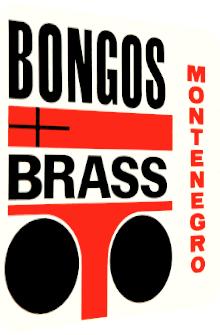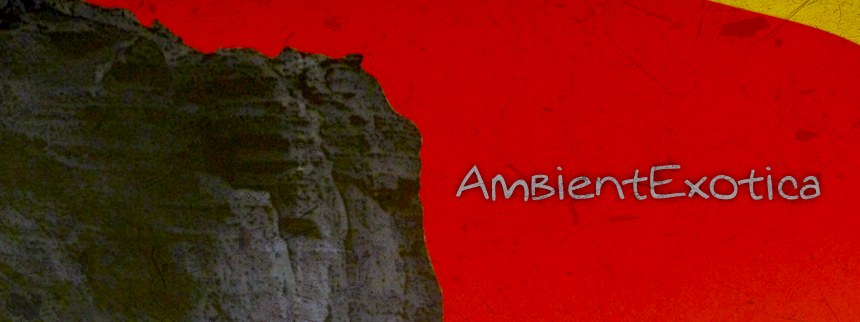
Hugo Montenegro
Bongos And Brass
1960
Conductor and orchestra leader Hugo Montenegro (1925–1981) is mostly known for his soundtrack to The Good, The Bad And The Ugly. If you consider its theme and stylistic soundscape, his Exotica-related entry of 1960 is a completely different affair. Thanks to the bongo craze at the time, Montenegro was approached by the people at Time Records to enter the domain of Don Ralke and come up with an entry himself. The result is called Bongos And Brass which is nowadays also known as Montenegro And Mayhem thanks to the 2010 digital re-issue which was scheduled for the album's 50th anniversary. Its original title, however, is much more descriptive, if naturally less exciting: the regular appearance of bongolicious percussion sections is the signature element of this LP, as are of course the many brass players involved in the process of creation.
12 renditions are presented, and the chosen material tends to be highly distinctive as the listener will notice right from the get-go, but more about this in the following paragraphs. Otherwise, the tracks comprise of less-known Jazz standards if you take an Exotica circle as the base. Of further note is the lack of any truly exotic cut. It is the music itself that becomes more or less exotic in the hands of Hugo Montenegro. Given this setup, I am quite fond of Bongos And Brass which, on the other hand, is almost universally Crime Jazz-focused. The brass stabs are crisp and darkly brooding, the bongos add the feeling of frenzy to the scenery. But at the end of the LP, everything changes once again. Read more about all of the 12 takes below.
If you see Bongos And Brass as a dedicated Exotica album due to its title alone, the first composition will already blow your mind, as it is hugely unexpected: the classical In the Hall Of The Mountain King by Edvard Grieg is presented here with the expected bass tuba and mountain side timpani, but the spy theme and jungle flavor soon rise when shedloads of brass bursts and stabs are unleashed by Montenegro in adjacency to the bongo groove. The sudden shifts into red-tinted Latin timbres round this wild ride off, making this tune the signature track of the LP already. It is not my favorite take in this incarnation, but nonetheless highly unique and never heard before in this specific way. A rendition of Philip Braham's and Douglas Furber's Limehouse Blues follows and launches with a gargantuan but euphonious cliché of Chinese brass sequences, a hollow bongo aorta and bumblebee-resembling trumpets. After the wonderfully Asian start, the North American big band feeling takes over, making this a swinging but not all too surprising try. I am, however, fond of the long percussion solo full of, well, bongos, cowbell and claves.
While the five minutes long rendition of Richard Rodgers's (off Bali Ha'i fame) Slaughter On Tenth Avenue delivers the cinematic scope it promises in its title thanks to woodpecking bongos, a time-shifted rising show tune-esque theme of eight or nine brass instruments and a tempo shift into downbeat territory, it so happens that another composition by Richard Rodgers is featured afterwards which he co-wrote with Lorenz Hart; the less than romantic Lover actually unites liquedous bongo droplets with punchy brass blebs. Hugo Montenegro circumvents the notions of its title and makes this a surprising tune. Up next is Lonesome Road, originally written by Nathaniel "Nat" Shilkret, a tune I am not particularly fond of due to its oscillation between sleazy and eupeptic tonalities. Only the warm-hearted chorus succeeds in my opinion because of the four leading brass players and the respective echoes. Even the inclusion of the bongos wears all too thin on this level. Duke Ellington's Cottontail closes side A with an orchestra cymbal-fueled groove with jumpy muted trombones and the unexpected omission of the heretofore omnipresent bongos. Depending on one's respective viewpoint, one either despises this arrangement due to that glaring omission or tends to love it for this very reason.
Side B launches with another tune by Duke Ellington, the almighty Take The "A" Train. The tick-tocking bongos are back in full force and placed in-between sunny piano chords – a first on Bongos And Brass – and various muted brass instruments. Cool wah wah trumpets find their way into the mix as well, and especially the upwards spiraling flourish makes Montenegro's rendition a worthy contender. It is a bit too slow for my taste, but whatever, it is fabulous. The following tune is the greatest one on Montenegro's album, I believe: Irving Berlin's Heat Wave features the most tropical groove, comprising of those bongos, maracas, guiros and snake-resembling tambourins. The main melody is played on brazen tin-resembling drums in the veins of steel pans, albeit much more clonky. The plasticity of this setting is so successful that even the double bass accents and acoustic guitar rivers can be heard. The convivial brass layers are only entering much later, taking over on the six-note melody. A gorgeous tune, and totally exotic! It even beats Rene Paulo's already stellar, but much mellower version off his 1963 album Tropical Heat Wave.
Whereas Count Basie's and Eddie Durham's One O'Clock Jump widens the instrumental pool further since Montenegro adds mysterious vibraphones next to the piano sprinkles and legato brass layers which grow in piercing intensity, Oscar Hammerstein II.'s and Sigmund Romberg's Lover, Come Back To Me opens in a military march-like manner but soon morphs into the archetypical Saturday night swinging tune of the prohibition era. The textures of the horns and the jazzy piano infusion are its signature elements, for the bongos are seldom heard. It is the take on Moisés Simóns' most-famous hymn The Peanut Vendor which brings back the bongos into the spotlight, with clicking claves accompanying the largest ensemble of different brass instruments yet, making this sun-soaked version a feast for the ears! The final tune Laura by David Raksin and Johnny Mercer rounds the album off with the mellowest and dreamiest brass fanfares. They are so mellifluous that the bongos sound like acidic raindrops in comparison. The piano placenta works as marvelously as the multilayered euphony of the silkened horns. This tune is another hit, for it truly breaks the endemic boundaries of the album with a heretofore unheard smoothness. A classic!
The included rendition of Heat Wave has the description "successful Exotica" written all over it, whereas the closing track Laura is admittedly less exotic, but tremendously phantasmagoric and hence in a class of its own. Hugo Montenegro's LP might seemingly drift into ephemeral waters all too often, for its gimmicky bongos in-between the huge horn avalanches wear potentially thin in terms of their novelty. But mind you, Bongos And Brass ultimately succeeds with its coherence for two reasons: firstly, side A sets the mood and pace, but side B has the better tunes. This, secondly, has to do with the expanded pool of instruments which are all too seldom included, but if they are, variety ensues: gelid vibraphones, snugly piano chords and these superbly exotic and metallic-clonky drums akin to steel pans altogether cause a fissure in the solidly baked formula.
Fans of Don Ralke or even George Cates' singular Exotica work called Polynesian Percussion (1961) will be all over this release, but I deem it compatible to another clientele's taste, namely Crime Jazz afficionados who want their ears to be literally hit by the brass eruptions. The classical Jazz flavor – referring to ebbing and flowing double bass melodies and convoluted trumpet solos – is surprisingly slim since the scope is much bigger. As I've stated in this paragraph already, go for Heat Wave if you want the truly exotic cut on this release, which is luckily available on iTunes and Amazon. No CD was ever pressed to my knowledge, but the vinyl is also fairly common and sold on the usual plattforms. The bongo craze and Hugo Montenegro never clicked together, making this album one of a kind in his discography, at least in terms of these devices being put in the spotlight.
Exotica Review 168: Hugo Montenegro – Bongos And Brass (1960). Originally published on Jan. 12, 2013 at AmbientExotica.com.
